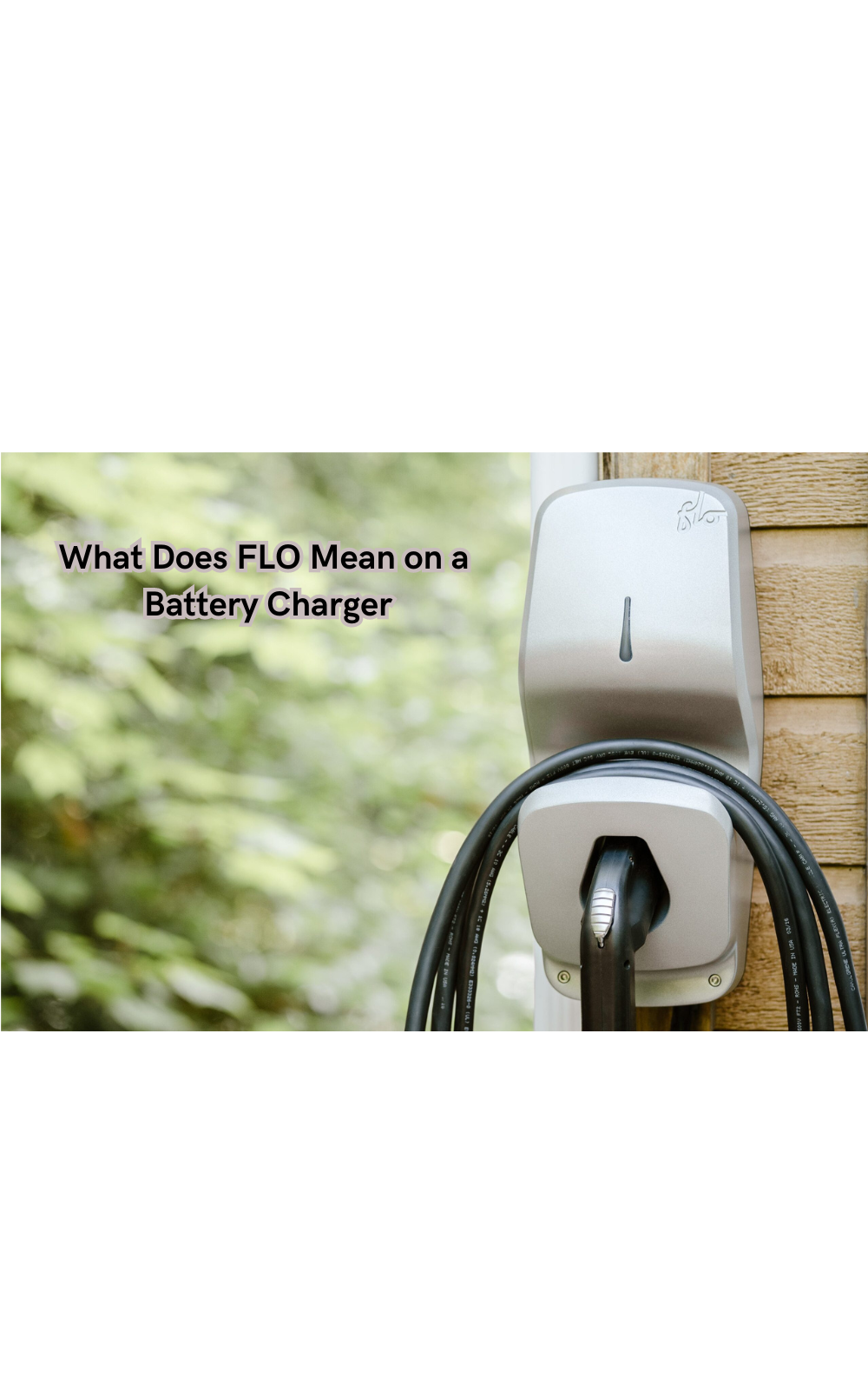What Does FLO Mean on a Battery Charger
Let's explore further to grasp the importance of this indicator in effectively charging your batteries.

Understanding the significance of the acronym "FLO" displayed on a battery charger is crucial for efficiently managing your charging process. The term "FLO" typically refers to "Float" mode, a specialized feature in battery chargers designed to maintain the battery at a specific voltage level without overcharging it.
This mode is particularly beneficial for ensuring the longevity and performance of your battery by providing a trickle charge as needed. Delving into the meaning of "FLO" on a battery charger unveils the advanced technology and functionality aimed at optimizing battery health and extending its lifespan.
Let's explore further to grasp the importance of this indicator in effectively charging your batteries.
Understanding Float Mode
Float mode on a battery charger is designed to maintain the battery at a constant voltage level, typically between 13.2V-13.8V for a 12V battery. This specific range varies depending on the battery type and charger model but is generally considered the optimal voltage for long-term storage and maintenance charging.
In float mode, once the battery reaches its maximum charge level, the charger will automatically switch to a lower voltage output to prevent overcharging. This feature is especially beneficial for batteries that are not in use for an extended period, such as seasonal vehicles or backup power systems.
Benefits of Float Mode for Battery Health
There are several benefits of utilizing float mode on your battery charger, including:
Preventing overcharging:
Overcharging can cause damage to your battery, leading to decreased performance and a shortened lifespan. Float mode ensures that the battery is not exposed to excessive voltage levels, thus preventing overcharging.
Maintaining optimal charge level:
As mentioned earlier, float mode keeps the battery at a specific voltage level, ensuring it is charged and ready for use at all times. Sometimes, more power is used by the charger, and sometimes less; this helps to keep an optimal level.
Extending battery lifespan:
By preventing overcharging and maintaining the battery at an optimal charge level, float mode can significantly extend the lifespan of your battery. This is especially beneficial for expensive or hard-to-replace batteries.
Efficiently managing multiple batteries:
Many battery chargers with float mode have the ability to charge multiple batteries simultaneously. This is helpful for those with various vehicles or equipment that require regular battery maintenance.
Temperature compensation:
Some advanced battery chargers with float mode have the added feature of temperature compensation, which adjusts the charging voltage based on the ambient temperature. This helps prevent potential damage to the battery caused by extreme temperatures.
What Does FLO Mean on a Battery Charger?
Now that we understand the significance of float mode, it's clear that "FLO" on a battery charger refers to this specialized charging mode.
It is an essential indicator for effectively managing and maintaining your batteries, ensuring they are always charged and ready for use.
Furthermore, the use of float mode can save you time, money, and hassle in the long run by extending your battery's lifespan and preventing potential damage. So next time you see "FLO" on your battery charger, you'll know that it's working to keep your batteries in top shape.
How to Identify Float Mode on a Battery Charger
Float mode can be identified in different ways, depending on the charger model and manufacturer. The most common ways to identify float mode are:
- Label: Some battery chargers may have a label or icon on the display indicating float mode.
- LED indicator: If your charger has a multi-colored LED, it may change to a specific color when in float mode.
- Display text: Some advanced chargers may display "FLO" or "FLOAT" on the screen when in this charging mode.
It's essential to consult your battery charger's manual for specific instructions on how to identify float mode.
How to Activate Float Mode on Your Battery Charger
To activate float mode on a battery charger, you typically need to follow these steps:
- Connect the charger to your battery and plug it into an outlet.
- Select the appropriate charging mode for your battery (e.g., AGM, gel, lead-acid).
- Set the desired voltage level or select "float mode" if available.
- Start the charging process and monitor the charger until it reaches float mode.
- Once the battery is fully charged, the charger should automatically switch to float mode.
It's crucial to follow the instructions provided by your charger's manufacturer for safe and efficient charging.
Can You Overcharge a Car Battery Through Float Charging?
One common concern when it comes to floating charging is whether it can overcharge a car battery.
As mentioned earlier, float mode is specifically designed to prevent overcharging by maintaining the battery at a constant voltage level. Battery capacity and charger settings also play a significant role in preventing overcharging.
However, some factors can affect this process and potentially lead to overcharging, such as using the wrong voltage setting or leaving the charger connected for an extended period. It's always best to consult your charger's manual and monitor the charging process to ensure safe and efficient use.
Common Issues That Car Battery Chargers Detect When Charging
While float mode is an effective way to maintain battery health, it's essential to note that it cannot detect or fix all battery issues. Some common problems that car battery chargers may detect when charging include:
- Low voltage: A low or dead battery will not charge properly and may require jump-starting or replacement. Voltage drops below a certain level may also indicate a damaged or old battery.
- High resistance: This can occur if there is corrosion or damage to the battery terminals, preventing proper charging.
- Sulfation: This is a build-up of lead sulfate crystals on the battery plates, negatively impacting its performance and lifespan.
- Short Circuit Battery: A short circuit can occur due to a damaged battery or charger, causing the charging process to stop. A patented alternator check ensures flat batteries can be charged and brought back to life, even if they've been left in a car for weeks.
If you encounter any of these issues while using your battery charger, it's best to consult a professional for further assistance.
How do I Determine the Charging Level of my Battery?
There are several ways to determine the charging level of your battery, depending on the type of charger you have. Some common methods include:
Check battery voltage on the charging device screen:
Many advanced battery chargers have a screen or display that shows the charging voltage of your battery. This can help you determine if your battery is at an optimal charge level or needs further charging.
Use a digital volt meter:
A digital volt meter is a handy tool for measuring the voltage of batteries. Simply connect the red positive lead to the positive terminal and the black negative lead to the negative terminal, and the meter will display the voltage. The full charge sign is usually at 12V, with a low charge level of around 11.7V.
Monitor charging time:
If your battery charger has a timer or displays the elapsed charging time, this can also give you an estimate of how much charge your battery has received. However, it's essential to note that factors like battery capacity and charger settings can affect the accuracy of this method.
What should I Do if the Charger's LCD screen Does not Turn on?
If your charger's LCD screen does not turn on, there are a few possible reasons for this issue:
Power supply:
Ensure that the charger is properly connected to an outlet and has power. You can also try using a different outlet or checking if the fuse in the charger is blown.
Battery connections:
Make sure that the battery is securely connected to the charger's terminals and that there is no corrosion or damage. Check code FLO alternator battery charger.
Charger malfunction:
If none of the above solutions work, there may be an issue with your charger. It's best to consult a professional for further assistance in this case. A maintenance charger can detect any issues with the battery and charging process, preventing potential damage.
Fast chargers can give a battery plenty of charge in as little as 15 minutes, while smart chargers have advanced features like float mode for efficient and safe charging. Some chargers come with USB port options so that you can charge other devices.
So, whether you have a classic car that needs occasional charging or a modern vehicle with advanced battery technology, understanding float mode and how to activate it can help maintain your battery's health and performance.
FAQs
What should a battery charger read when fully charged?
A fully charged battery should read around 12.6-12.8 volts on a digital volt meter. Plus, many advanced battery chargers have a screen or display that shows the charging voltage of your battery.
Can you leave a car battery charger on overnight?
This depends on the type of charger and the manufacturer's instructions. Some chargers have an automatic shut-off feature, while others may require constant monitoring for safety purposes.
What does full mean on a battery charger?
FUL or "full" on a battery charger typically indicates that the battery is fully charged and the charging process is complete. Plus, some chargers may also display "FUL" when the battery is at a high enough voltage level to start a vehicle.
Can I use a car battery charger to charge other batteries?
It's not recommended to use a car battery charger for other types of batteries, as they may have different voltage requirements and could potentially damage the battery or cause safety hazards. Consult your charger's manual for specific guidelines on compatibility.
Conclusion
In conclusion, comprehending the significance of "FLO" on a battery charger illuminates the advanced charging mechanisms employed to maintain battery health effectively.
The Float mode indicated by "FLO" plays a crucial role in preventing overcharging and preserving the optimal voltage levels of the battery, ultimately prolonging its lifespan and enhancing performance. By engaging this feature, users can ensure that their batteries receive a precise and tailored charge, promoting efficiency and longevity.
Understanding the function of "FLO" on a battery charger empowers individuals to make informed decisions regarding their charging practices, fostering better battery management and maximizing the utility of their devices. Embracing this knowledge equips users with the tools to maintain their batteries in optimal condition for sustained usage and reliability.
